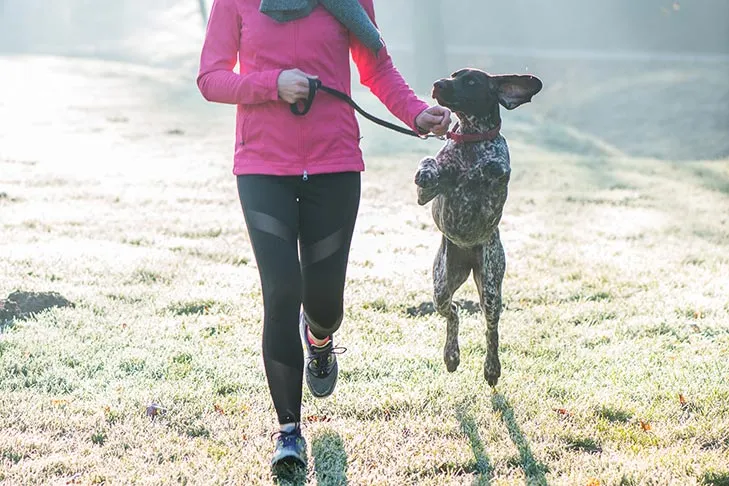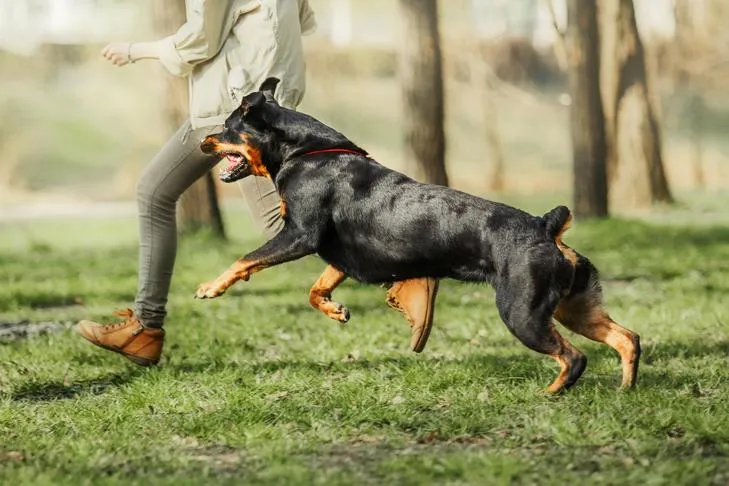Running alongside your canine companion can be an incredibly rewarding experience, fostering a deeper bond and promoting mutual fitness. As a dedicated dog owner, you understand that a healthy lifestyle for your furry friend extends beyond walks. Incorporating running into your routine offers a fantastic way to keep both of you in peak physical condition, with the added bonus of having a consistent motivation to hit the pavement. Before embarking on this journey of training your dog to be the ultimate running buddy, it’s crucial to be well-informed and prepared. This guide will walk you through the essential steps to ensure a safe, enjoyable, and successful running partnership.
Choosing the Right Dog and Age for Running
The first step in training your dog to run with you involves assessing their suitability for this activity. Not all dogs are built for long-distance running, and age is a significant factor. Puppies, whose bones are still developing, should not engage in strenuous running. For most breeds, it’s advisable to wait until they are at least 1.5 years old before introducing them to a running program. This waiting period allows their skeletal structure to mature sufficiently.
Beyond age, breed characteristics play a vital role. Research your dog’s breed to understand their natural athleticism, stamina, and potential predispositions to certain health issues that might be exacerbated by running. Temperament is also a key consideration; some dogs are naturally more energetic and eager to please, making them excellent candidates for running partners. Ultimately, a visit to your veterinarian for a thorough physical checkup is indispensable. Your vet can confirm your dog’s overall health and provide personalized advice on whether running is a safe and appropriate activity for them. Understanding these initial prerequisites will lay a solid foundation for your training efforts. For those concerned about specific behaviors, understanding how to train your dog to run next to you can address some of these concerns early on.
 German Shorthaired Pointer running with a woman in the early morning. ©Laszlo Lorik – stock.adobe.com
German Shorthaired Pointer running with a woman in the early morning. ©Laszlo Lorik – stock.adobe.com
Mastering the Walk Before the Run
A fundamental principle of training your dog to run with you is mastering loose-leash walking first. A dog that pulls enthusiastically on the leash during walks can become a significant hazard when you pick up the pace. The distractions of the environment – enticing smells, passing squirrels, or other dogs – can make it challenging for your dog to stay focused on you. Therefore, establishing a strong foundation in loose-leash walking is paramount.
The goal is to have your dog walk comfortably by your side, with the leash hanging in a relaxed “J” shape. To achieve this, consistent positive reinforcement is key. Utilize high-value treats, their favorite toys, and abundant praise to reward your dog whenever they maintain a slack leash. This positive reinforcement strategy helps your dog associate staying near you with pleasant outcomes. Furthermore, deciding which side your dog will run on is crucial. Whether it’s the left or right, pick one and consistently train them to stay on that specific side. This prevents them from weaving in front of you or getting tangled in the leash, which can lead to trips and falls. Start this training at a walking pace, and pay close attention to where you deliver your rewards. If you want your dog on your left, always offer treats at your left leg. Once they’ve mastered one side, you can then train the other. For enhanced control and comfort during runs, you might consider using a hands-free dog leash. If you find yourself dealing with a dog that is too eager to bolt, learning how to train your dog to run alongside you can be beneficial.
 Rottweiler running in the park playing with its owner. ©OlgaOvcharenko – stock.adobe.com
Rottweiler running in the park playing with its owner. ©OlgaOvcharenko – stock.adobe.com
Introducing Speed Cues for Running
Once your dog has a good grasp of walking politely by your side, it’s time to introduce the concept of running. Just as you have cues for other behaviors, introducing specific verbal cues for “going faster” can significantly improve your dog’s understanding and response. For example, a cue like “let’s go” might signal the start of movement, while a distinct cue such as “get running” or “move it” can tell your dog it’s time to pick up the pace. The more information you provide your dog about your expectations, the more effectively they will be able to respond.
To teach these running cues, intersperse short bursts of jogging or running within your regular walking routine. Immediately before you increase your speed, deliver your chosen running cue. Reward your dog with praise and a treat when they quickly adjust their pace to match yours. Conversely, you can also teach a “slow down” cue, such as “whoa,” to indicate when it’s time to transition back to a walk. This systematic approach ensures your dog understands the transition between different gaits.
Building Endurance Safely and Effectively
With your dog now able to stay by your side and match your pace, the next crucial step is to gradually build their endurance for longer running sessions. Just like humans, dogs require a progressive approach to developing strength and stamina. Start by incorporating short intervals of running into your walks. As your dog becomes accustomed to these bursts, gradually increase the duration of your running segments on each subsequent outing, while simultaneously decreasing the walking portions.
This gradual increase in intensity and duration allows your dog’s cardiovascular system and muscles to adapt safely. Over several weeks, you will likely notice a significant improvement in their ability to sustain running for longer periods. This progressive conditioning is vital to prevent injuries and ensure your dog enjoys the experience. This phase is critical for long-term success and enjoyment, ensuring your dog can keep up with you. If you’re concerned about your dog’s overall ability to stay focused and in sync, exploring how to train your dog to run with you can provide further insights.
 ©Przemyslaw Iciak – stock.adobe.com
©Przemyslaw Iciak – stock.adobe.com
Essential Tips for a Safe and Enjoyable Running Experience
Once your dog is trained and conditioned to be your running companion, it’s essential to implement practices that ensure their safety and maximize their enjoyment. Adhering to these tips will make every run a positive experience for both of you.
- Warm-up and Cool-down: Always begin your runs with a brisk walk for a few minutes to warm up your dog’s muscles. Similarly, conclude your runs with a cool-down walk to help their heart rate return to normal and prevent stiffness.
- Weather Awareness: Dogs are more sensitive to heat and humidity than humans. Be acutely aware of the weather conditions and avoid running during the hottest parts of the day or in extreme heat.
- Hydration: Carry water with you on your runs and offer it to your dog regularly, especially during warmer weather or longer distances.
- Frequent Breaks: Allow your dog frequent breaks to rest, rehydrate, relieve themselves, and simply enjoy their surroundings. This prevents overexertion and keeps the experience positive.
- Off-Leash Safety: Only permit your dog to run off-leash in areas that are safe, legal, and where they have a reliable recall command, even amidst distractions. Safety should always be the top priority.
- Monitor Your Dog: Pay close attention to your dog’s body language for signs of fatigue, such as excessive panting, lagging behind, or a reluctance to continue. Remember, dogs often strive to please their owners and may push themselves beyond their limits if not monitored. If you are concerned about your dog’s tendency to bolt, learning how to train your dog to run next to you is highly recommended.
Conditioning in Extreme Weather
For dedicated runners, the desire to maintain fitness extends beyond ideal weather conditions. However, extreme cold or heat can pose a significant risk to your dog’s well-being. When outdoor running isn’t feasible, indoor activities can help maintain your dog’s physical conditioning. For smaller to medium-sized dogs, games of fetch down a long hallway or up and down carpeted stairs can effectively elevate their heart rate and engage their muscles.
You can also create an impromptu agility course using household items like hula hoops or cardboard boxes. Many professional training facilities offer indoor agility classes, providing a stimulating environment for your dog to run and jump. For a more controlled indoor workout, a treadmill can be a valuable tool. While some treadmills are specifically designed for dogs, a standard human treadmill can also be used. Ensure the treadmill is long enough to accommodate your dog’s stride. It’s crucial to introduce your dog to the treadmill gradually and safely. Consult reputable resources on treadmill training for dogs or work with a professional trainer to ensure your dog uses the machine comfortably and safely. Never tie your dog to a treadmill or leave them unsupervised while it’s in use. Understanding how to prevent escape can be particularly useful if your dog has a tendency to run away, such as if your dog breaks out of his crate.
Running with your dog is a journey that requires patience, consistency, and a deep understanding of their needs. By following these comprehensive training steps, focusing on their well-being, and adapting to their individual capabilities, you can build a strong and enjoyable running partnership. Remember, the bond you forge through shared activity is as beneficial as the physical health it promotes. If you encounter persistent challenges, consulting a professional dog trainer can provide personalized guidance and support to help you and your canine companion achieve your running goals.
